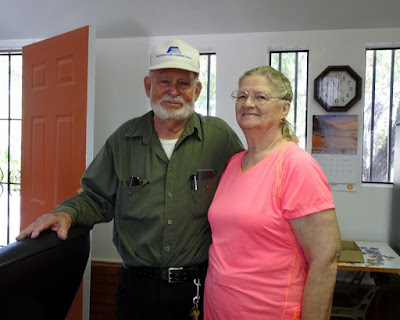Saturday, February 11 – Since Marsha is using Blogger right now to post, if you use Feedly to read the blog, you may notice extra blank lines. You might want to consider reading the post on our website.
We enjoyed strolling around Ajo, AZ, this morning at the weekly farmer's market. It wasn't very big but was certainly well attended. The only purchase we made was a cup of coffee and a breakfast burrito. Our contribution to the struggling local economy.


Ajo is an historic mining town. Once part of Mexico, the Spanish mined silver here as far back as 1750. The entire town was built to house and support the Cornelia Mine that opened in 1914. In 1931 The Phelps Dodge Corporation acquired the mine and most of the town. By 1960, the population of Ajo swelled to over 7000 people. In 1984, during a bitter strike, the mine closed causing many families to leave town. We took a tour of Ajo by following a self-guided walking tour.
The old railroad station is now the visitor’s center.
 The Plaza.
The Plaza.


There are two churches across the street from the Plaza where the farmer's market was held. The Immaculate Conception Catholic Church completed in 1925 is an adobe construction and very simply done both inside and out.


Not to be outdone, the Federated Church, designed in 1926 and directly across the street, lacks almost all ornamentation. We were not able to enter the church.

The former Curley School, located at the end of Lomita Street which begins at the square, has been totally renovated to provide living and work space for 30+ artists. This school was originally owned by the New Cornelia Phelps Dodge Mining Company.
 Beautiful architecture.
Beautiful architecture.




A very nice art gallery.

We then drove up to an open-pit mine viewing area to see the New Cornelia mine. WOW! One and a half miles across and 1100 feet deep, the mine was one of the largest in the country at one time. At one time, it was the largest producer of copper in Arizona. Gold, silver, and molybdenum were also mined here.

We were so fortunate to meet Bob Hightower at the viewing area. He is now the Ajo Historian and worked over 35 years at the mine. He volunteers at the Mine Museum and is a wealth of information about the mine and the city of Ajo. He gave us a printed information sheet, but it was nothing compared to the information he shared with us. He recalls working at the bottom of the pit during the summer where temperatures reached 165 degrees. To reach the bottom of the pit, one would ride a train down the spiraling route 32 miles. It took over 6 hours for a fully loaded train to travel out of the pit.

They could drive the train without being in the engine.
What one of the trains looked like.
Over 200 men worked on the railroad alone! Bob spoke to us for over an hour. We were mesmerized with his knowledge. He and his wife volunteer at the mine Visitor's Center six days a week, so be sure to speak with him if you ever visit the mine.
We really enjoyed our day in Ajo, AZ. A town full of very friendly people.
Thanks for stopping by. Hope to see y’all back real soon. Have a great day!




























